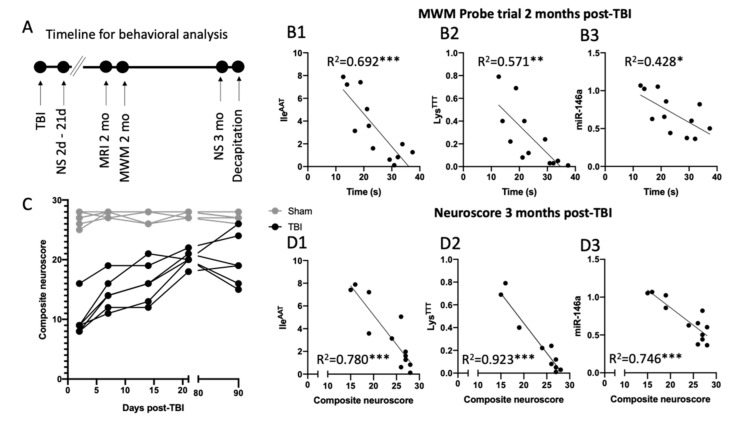Figure 10.
Upregulation of tRFs in the ipsilateral thalamus correlated with a worse behavioral outcome after traumatic brain injury (TBI). (A) Neuromotor function was assessed by the composite neuroscore at acute and chronic time-points post-TBI, and memory deficits were investigated with the Morris water maze at 2 months post-TBI. (B1–B3) Correlation analysis showed that rats showing deficits in the probe trial, represented by less time spent in the correct quadrant, also had the highest expression of the full miR-146a profile (all isomiRs included; Spearman r = 0.43, p < 0.05, panel (B1)), 3′tRF-IleAAT (Spearman r = 0.70, p < 0.001; panel (B2)), and 3′tRF-LysTTT (Spearman r = 0.57, p < 0.01; panel (B3)). (C) TBI rats exhibited acute motor function deficits compared with controls at 2 days post-TBI (p < 0.01) with recovery to subacute at 7 days (p < 0.01, compared with controls), 14 days (p < 0.01, compared with controls) and 21 days (p < 0.01, compared with controls) post-TBI time-points. At 3 months post-TBI, high variance in the measured score was observed between rats, but lower scores were still observed compared with controls (p < 0.01). (D1–D3) Correlation analysis indicated a relation between a lower neuroscore value at 3 months post-TBI and increased expression of the full miR-146a profile (all isomiRs included; Spearman r = 0.75, p < 0.001; panel (D1)), 3′tRF-IleAAT (Spearman r = 0.78, p < 0.001, panel (D2)) and 3′tRF-LysTTT (Spearman r = 0.92, p < 0.001; panel (D3)). Statistical significance: *, p < 0.05; **, p < 0.01; ***, p < 0.001.

